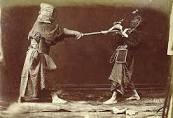 Last week’s post prompted some interesting questions. Tsuki as a technique is as important as men, kote and dou. As with attacks to all of these targets ippon is generated by a sharp, accurate on-off strike. Debana tsuki like debana men is made just as the opponent starts an attack. You should strike just as he starts to lift his hands, so it is up to you to step-in and hit the men dare.
Last week’s post prompted some interesting questions. Tsuki as a technique is as important as men, kote and dou. As with attacks to all of these targets ippon is generated by a sharp, accurate on-off strike. Debana tsuki like debana men is made just as the opponent starts an attack. You should strike just as he starts to lift his hands, so it is up to you to step-in and hit the men dare.
Mukaetsuki is a tsuki that meets your opponent’s forward movement as he steps in to attack. Not only are you holding him off with the shinai’s point, you are increasing the force with which you receive him by pushing your hands forward at the same time. This is not only bad behaviour, it is dangerous as the shinai can cause damage if it slips under pressure and goes under the tsuki dare.
Daniel made reference to some kodansha hitting the target and releasing the tension in this situation. He also mentioned holding the shinai against the attacker’s dou mune. To make sense of this, it is essential to realise that practice between juniors and seniors is different to that between peers. This hikitatgeiko is similar to jigeiko or gokakugeiko, but the senior takes the lead in encouraging good strikes and in using his own technique to pre-empt or block bad ones. This holding (but cushioning) kamae against a forward moving kenshi is normally done to teach the student about distance and timing.
As for walking away after striking, kodansha develop bad-habits like everyone else, although this could be an initiative by sensei to move you back to the right spot for keiko and to avoid leaving you in a space where you might bump into other players. Senior level zanshin may well be on the spot and not involve excess movement, but the strength of the attack and kiai and manifestation of kigamae would make it very clear that sensei had made a successful yuko datotsu.
Sumi sensei’s show of dropping into sonkyo after kaeshi dou is as suggested a humorous way to emphasise a point. I have seen him do this too. He is not alone in concluding keiko in this way. Arima sensei of Osaka police was well known for taking kote or tsuki and immediately squatting, but he amplified the effect with his distinctive high pitched kiai as he wrapped things up by calling out something along the lines of “otsuki, otsuki, sainara (sayonara with a Kansai accent).










